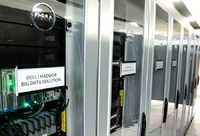5 Myths and Truths About Big Data

I believe in “big data” just like I believe in the power of all data to transform our lives. Just look at the powerful applications already emerging in healthcare, world hunger, global economics, and even for those for whom hockey is more important than life itself, sport competiveness.
The opportunity in marketing and business intelligence is just as strong. Our digital lifestyles generate a tremendous amount of personal and behavioral data – in fact, IDC estimates that by 2020, the number of commercial transactions on the Internet (both B2B and B2C) will reach 450 billion per day. McKinsey forecasts that demand for “big data” in the U.S. will create up to 190,000 high-paying jobs requiring deep analytical skills by 2018.
Used responsibly, all that data has a very meaningful impact on our lives and the economy. It’s time to clear up some of the myths surrounding big data and what it can do for marketers.
No. 1 Myth: “Big Data” Has a Universally Accepted, Clear Definition
Truth: Not so! Lots of people have trouble with what criteria to use in defining “big data.” That makes it easy to use in all kinds of contexts – including contexts where another term might be more appropriate. Size alone is not big data, but also scope and how it’s processed. Akamai analyzes more than 75 million events per day to better target advertisements.
To help you form your own internal definition, “big data” is usually thought of in these terms:
The dramatic increase in the quantity of data available to be stored and analyzed in today’s economy.
The inclusion of “unstructured” data (meaning it is non-numeric, “free-form,” qualitative data such as text, video, social content, and click-stream patterns), which requires sophisticated new data extraction and analytic techniques in order to be usable for business purposes.
The growing role of automation in the use of data, e.g., creating and delivering marketing messages in real time.
No. 2 Myth: Big Data Is New
Truth: While the sheer volume of data available in this day and age, and our ability to process it at a high level are certainly new, the concept of correlating and analyzing vast volumes of information is certainly not. For example, huge cross-references of every single word used in the Bible, called “concordances,” were in use by scholar monks for centuries well before the first databases.
No. 3 Myth: “Big Data” Means “Big Marketing”
Truth: Often the most effective uses of big data are not bigger marketing, but leaner, more efficient marketing. The biggest challenge now is to wrestle big data down into actionable insights. Understanding the full experience means managing data from many sources, in many formats (like transactions, social sentiment, online behavior), and often in real time. A hotel company wants to both improve the spend during each visit, and increase the number of visits per year. Competing offers must be corralled and messaged in the right context. You can’t do that at any kind of scale without effective marketing analytics.
While the use of data in marketing is universal, spending on “big data” is not yet pervasive. An estimated $11.4 billion was spent on big data investments in 2012. Of this, over $3 billion was spent by Google, and over $1 billion was spent by Facebook. By Stephanie Miller Read more

























